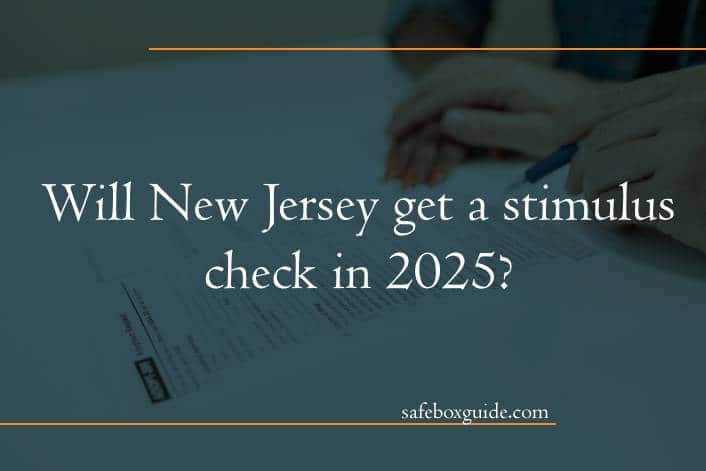As the clock ticks forward into 2025, many New Jersey residents find themselves pondering a question that could significantly impact their financial landscape: Will they see another stimulus check? The echoes of economic uncertainty resonate through bustling cities and quiet suburbs alike, leaving families to navigate rising costs of living, inflationary pressures, and the lingering effects of past financial crises. What once seemed like a temporary measure has transformed into an ongoing conversation about fiscal support from state governments.
In this context, New Jersey stands at a crossroads—balancing its budget while addressing constituents’ pressing needs for immediate relief. As lawmakers deliberate on potential measures to bolster the economy and provide aid to struggling families, speculation runs rampant about what the future holds. Whether you’re cautiously optimistic or skeptical about government intervention in these challenging times, understanding the nuances behind potential stimulus initiatives is crucial for planning ahead. Join us as we explore the possibilities and implications surrounding New Jersey’s financial future in 2025—an inquiry that not only affects wallets but also shapes communities across the Garden State.
Contents
Historical Context: Previous Stimulus Checks in NJ
New Jersey’s experience with stimulus checks has unfolded against a backdrop of economic uncertainty and evolving state policies. When the COVID-19 pandemic hit, New Jersey was among the states that swiftly enacted financial relief measures to support citizens. The 2020 Economic Impact Payments sent $1,200 to eligible individuals, while subsequent programs extended targeted aid to families, particularly those in lower income brackets. However, these checks were just part of a broader tapestry of fiscal strategy, highlighting how state leaders balance immediate relief with long-term economic stability.
Historical analysis reveals that past stimulus initiatives have often been tied not only to crises but also to shifts in political landscapes and public priorities. For instance, beyond federal responses, Governor Murphy’s administration implemented various cash assistance programs aimed at housing stability and food security during heightened times of need. As we contemplate future stimulus possibilities for 2025 amidst lingering inflationary pressures and socioeconomic recovery challenges, it is essential to evaluate what worked previously—both successful mitigation strategies and shortcomings. This synthesis will be vital as lawmakers consider whether direct payments or alternative relief forms are necessary for an ever-evolving citizen landscape where economic disparities remain a pressing concern.

Current Economic Situation in New Jersey
New Jersey’s economic landscape is a tapestry of resilience and challenge. As we navigate through the aftermath of the pandemic, the state has seen an encouraging rebound in job growth, particularly in sectors like technology and renewable energy. However, this recovery isn’t uniform, with certain areas still grappling with high unemployment rates and increasing living costs. The state’s hefty tax burden continues to place pressure on households, prompting many to question how sustainable this recovery truly is.
Moreover, as inflation persists across the nation, New Jersey’s consumers are increasingly feeling the pinch at grocery stores and gas pumps. While local businesses strive to adapt by updating their supply chains and embracing digital solutions, many residents express concern about potential long-term wage stagnation amidst rising prices. These economic complexities raise important questions about whether additional government support—like stimulus checks—could play a crucial role in stabilizing personal finances for struggling families by 2025; without it, New Jersey risks widening its socioeconomic divide even further.
Government Plans for 2025 Budget
As New Jersey eyes its 2025 budget, government officials are focusing on a mix of economic recovery and sustainable growth. The proposed allocations signal a strategic pivot towards bolstering public services and community resilience, particularly in the wake of economic challenges exacerbated by global events. Advocates for health care reform are optimistic about potential increases in funding for mental health services and Medicaid expansion, aiming to address gaps that have long plagued marginalized communities.
Moreover, infrastructure investments are taking center stage, as lawmakers prioritize upgrades to both roads and broadband access in underserved areas. This focus not only promises job creation but also aims to bridge the digital divide that has become increasingly evident during the pandemic. Supporting small businesses through direct aid programs is another cornerstone of the budget proposal, underscoring New Jersey’s commitment to fostering local entrepreneurship while stimulating consumer spending—an essential component for robust economic recovery. As these plans unfold, residents may find themselves more informed than ever about how state financing could directly impact their lives—and whether relief measures like stimulus checks might become part of the conversation come 2025.

Public Opinion on Additional Stimulus Checks
As discussions around potential stimulus checks in 2025 heat up, public opinion reveals a complex landscape influenced by varying economic realities. Many residents express skepticism about the effectiveness of one-time payments, citing concerns that such checks may merely serve as temporary relief rather than addressing deeper systemic issues like rising housing costs and stagnant wages. However, others argue passionately that immediate financial support is essential for families teetering on the brink of economic hardship, particularly in light of ongoing inflationary pressures.
Furthermore, social media platforms have become a vibrant forum for diverse perspectives on this issue. Younger citizens, often burdened by student debt and precarious employment, advocate for direct cash assistance as a tool for fostering greater financial independence. In contrast, some older voters caution against reliance on government aid and urge state leaders to explore more sustainable solutions such as job training programs or tax reforms. This dichotomy highlights the need for policymakers to not only consider fiscal measures but also engage with constituents from all walks of life to ensure any approach taken resonates with the broader community’s values and aspirations.
Potential Eligibility Criteria for Residents
As New Jersey looks ahead to potential stimulus checks in 2025, understanding the eligibility criteria is crucial for residents hoping to benefit from such a program. Traditionally, income thresholds play a significant role in determining who qualifies; however, this time, there may be an emphasis on broader socioeconomic factors. For instance, low- and middle-income families could be prioritized, alongside those facing pandemic-induced challenges like job loss or increased healthcare expenses. Policymakers might also consider variables such as household size and geographic disparities within the state to ensure that assistance reaches the communities most in need.
Additionally, discussions around asset tests might emerge—evaluating not just income but overall financial stability. This could help target support towards those who struggle despite having modest savings or assets that alone do not indicate economic security. Furthermore, ongoing advocacy efforts may push for inclusion of historically underserved populations, such as immigrants or disproportionately affected minority groups. Engaging with local community organizations could serve as a bridge between residents and government programs, fostering transparency and awareness about these potential aid structures moving forward.

Comparison with Other States’ Stimulus Efforts
New Jersey’s approach to stimulus checks in 2025 will undoubtedly be scrutinized in comparison to the efforts of other states, each navigating their unique fiscal landscapes. While California has often led the charge with robust direct payments through its Golden State Stimulus program, New Jersey may find itself recalibrating its strategy based on lessons learned from initiatives across the country. For instance, Illinois recently implemented a temporary tax rebate system that targets low- and middle-income families, emphasizing an equitable distribution of funds—something New Jersey could mirror to effectively bridge socioeconomic gaps.
Moreover, states like Colorado have opted for more sustainable economic maneuvers by investing in long-term financial aid programs instead of one-time checks. This strategy reflects a shift towards resilience and stability rather than short-lived stimulus efforts. As New Jersey weighs its options, it must consider such innovative frameworks that prioritize not just immediate relief but also long-term recovery—possibly leading the way for comprehensive policies that foster community growth and economic vitality beyond 2025. Through understanding these diverse approaches, New Jersey has an opportunity to carve out its own path while also learning from both successes and missteps observed nationwide.
Conclusion: The Future of NJ’s Financial Aid
As New Jersey navigates the post-pandemic recovery landscape, the outlook for financial aid promises to be both challenging and transformative. With a palpable shift toward sustainability, there is an increasing focus on directing resources to more marginalized populations. Innovations in technology and data collection are reshaping how financial aid is administered; this could lead to personalized support systems that not only address immediate needs but also promote long-term economic stability for families.
The state’s potential stimulus checks may pave the way for expanded financial assistance programs, opening up discussions about integrating educational benefits with direct cash transfers. As policymakers grapple with these changes, community voices will play a crucial role in shaping equitable access to funds. Thus, NJ’s approach to financial aid may very well set a national precedent—encouraging other states to rethink their strategies as they face similar economic pressures. Whether through improving accessibility or dismantling existing barriers, the future holds compelling possibilities that could significantly transform lives across New Jersey, creating lasting impacts for generations to come.

